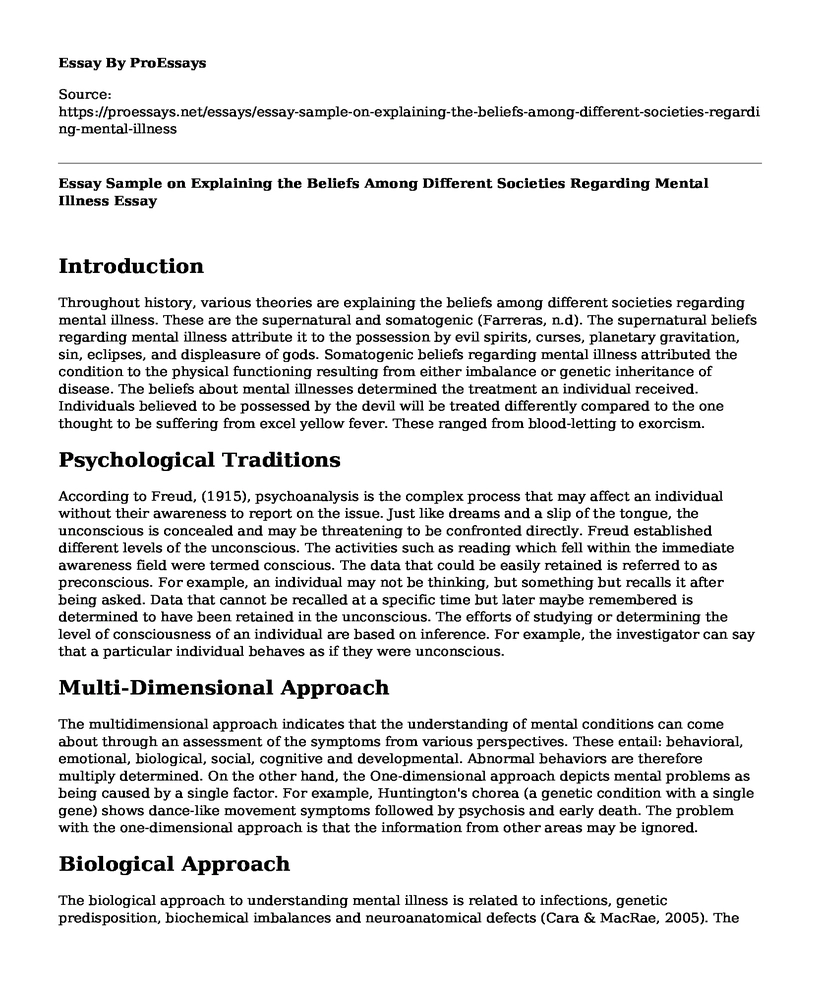Introduction
Throughout history, various theories are explaining the beliefs among different societies regarding mental illness. These are the supernatural and somatogenic (Farreras, n.d). The supernatural beliefs regarding mental illness attribute it to the possession by evil spirits, curses, planetary gravitation, sin, eclipses, and displeasure of gods. Somatogenic beliefs regarding mental illness attributed the condition to the physical functioning resulting from either imbalance or genetic inheritance of disease. The beliefs about mental illnesses determined the treatment an individual received. Individuals believed to be possessed by the devil will be treated differently compared to the one thought to be suffering from excel yellow fever. These ranged from blood-letting to exorcism.
Psychological Traditions
According to Freud, (1915), psychoanalysis is the complex process that may affect an individual without their awareness to report on the issue. Just like dreams and a slip of the tongue, the unconscious is concealed and may be threatening to be confronted directly. Freud established different levels of the unconscious. The activities such as reading which fell within the immediate awareness field were termed conscious. The data that could be easily retained is referred to as preconscious. For example, an individual may not be thinking, but something but recalls it after being asked. Data that cannot be recalled at a specific time but later maybe remembered is determined to have been retained in the unconscious. The efforts of studying or determining the level of consciousness of an individual are based on inference. For example, the investigator can say that a particular individual behaves as if they were unconscious.
Multi-Dimensional Approach
The multidimensional approach indicates that the understanding of mental conditions can come about through an assessment of the symptoms from various perspectives. These entail: behavioral, emotional, biological, social, cognitive and developmental. Abnormal behaviors are therefore multiply determined. On the other hand, the One-dimensional approach depicts mental problems as being caused by a single factor. For example, Huntington's chorea (a genetic condition with a single gene) shows dance-like movement symptoms followed by psychosis and early death. The problem with the one-dimensional approach is that the information from other areas may be ignored.
Biological Approach
The biological approach to understanding mental illness is related to infections, genetic predisposition, biochemical imbalances and neuroanatomical defects (Cara & MacRae, 2005). The problems with neurotransmitters and hormonal imbalances are identified as critical causes for mental disorders, for example, the presence or absence of chemicals interfering with the transmission process or the relationships between different transmitters such as stress (Cara & MacRae, 2005). Therefore, treatments entail the use of drugs targeting synaptic neurotransmitters.
Psychological Approach
The psychological approach focuses on the interaction between people and the surrounding environment or events. This approach typically investigates the events in individual's lives and how people have adjusted to these happenings. The inclusion of identified psychological elements in psychiatric formulations is meant to reveal certain client's feelings and needs (Cara & MacRae, 2005). Specific perceptions or activities are therefore identified to reflect, represent and infer cultural, social and personal meanings.
Emotions Approach
This approach focuses on interpreting emotional responses termed as inappropriate. For example, the individuals with brain injury on the left hemisphere tend to portray increased rates of emotional lability and depression. Moreover, the history of individuals is also identified as a critical determinant of their behavior. Clinical treatment of mental illnesses diagnosed through emotional approach aims at eliminating irrational beliefs such as the need for love and to be approved by all, being catastrophic when events do not favor an individual or striving to be perfect for one to consider themselves worth it.
Social and Cultural Approach
Social and cultural contextualization of individuals perceived to have a mental disorder is considered vital as people have different values regarding locus of control, individuality, formality, independence and even authority (Cara & MacRae, 2005). Understanding mental illness, therefore, has to include a comprehensive grasp of the changing perceptions such as time sense among individuals as these are the link that best describes their behavior. Social learning is a key recognizing the different cultural identities and incorporating their sensitivity within the treatment plan.
Developmental Approach
The development approach to mental illness focuses on an individual's personality and emotional growth (Cara & MacRae, 2005). Emphasis is however placed on early childhood experiences. This approach combines both internal processes and unconscious forces. Abnormal behavior is identified to emanate from conflicts between dynamic forces (intrapsychic conflict). The use of appropriate developmental activities helps identify the child's behavioral strengths and weaknesses. For example, children with personality disorders may fail to express themselves adequately through their behavior. The identification of such abnormal dynamics in development can help implement coping mechanisms.
References
Cara, E., & MacRae, A. (2005). Psychosocial occupational therapy: A clinical practice. Cengage Learning.
Farreras, I.G., (n.d.). History of Mental Illness. NOBA. Retrieved from https://nobaproject.com/modules/history-of-mental-illnessFreud, S., (1915). General psychological theory: Papers on Metapsychology. Retrieved from https://www.sas.upenn.edu/~cavitch/pdf-library/Freud_Unconscious.pdf
Cite this page
Essay Sample on Explaining the Beliefs Among Different Societies Regarding Mental Illness. (2022, Nov 06). Retrieved from https://proessays.net/essays/essay-sample-on-explaining-the-beliefs-among-different-societies-regarding-mental-illness
If you are the original author of this essay and no longer wish to have it published on the ProEssays website, please click below to request its removal:
- Essay Example on Racial and Ethnic Diversity
- Research Paper on Mental Healthcare
- Paper Example on Young Adults in Stress: The Impact of the Stressor
- Essay Sample on Rethinking Foster Care: Examining Challenges at the Micro-Level
- Essay Example on Effective Communication: Letting Emotions Guide Your Message
- Walter Reed Psychological Center: Multidisciplinary Behavioral Health Care in San Diego - Report Example
- Report Example on Remote Work Policies: Guidelines for Flexible Working







